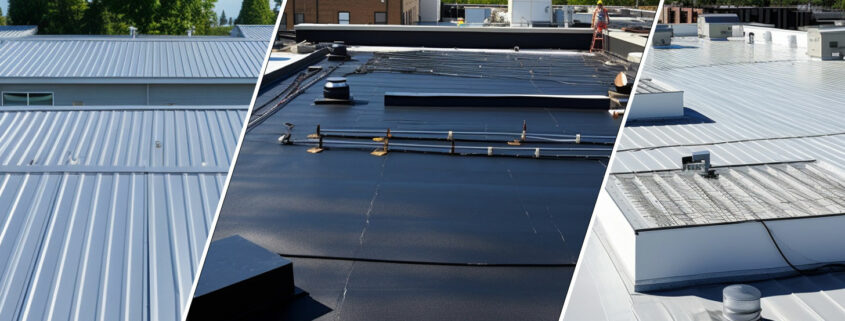If your commercial roof is nearing the end of its lifespan, then it’s important to get a handle on the different commercial roof types commonly used for replacement.
There are a lot of factors to consider when choosing a commercial roofing option, such as the slope of your building’s roof and the weather conditions in your area. Some roofing materials will be better suited for areas with high wind, and some won’t work as well in humid areas (which increases the rate of corrosion). Before you commit to your roof replacement, it’s important to consider all of the benefits and drawbacks of each roofing solution.
The Different Types of Commercial Roofing Systems
When it comes to commercial buildings, the slope of your roof will often play a part in determining what kind of material is best. Roofs are classified into two different types: steep-slope roofs, or low-slope roofs/flat roofs.
Steep-Slope Roofs
Steep slope roofs are more commonly used for residential roofing rather than on commercial buildings. A steep-slope roof has an incline greater than 4/12. Typically asphalt shingles are the most common material for this type of commercial roofing.
Low-Slope Roofs and Commercial Flat Roofs
Low-slope roofs and flat roofs are exactly that – roofs that have little to no incline. They’re the most common roofing system found on commercial properties. Typically, shingle roofing can’t be used on a roof with a slope under 2:12, so most commercial building owners use a different type of roofing material.
The Most Common Types of Commercial Roofing Materials
If you have a low-slope roof, then there are several roofing materials you can choose between when it comes to a new roof. There are benefits to each – some being more cost-efficient, some being more durable, and some offering increased energy efficiency. Below is a quick comparison of some of the most common types of material and how they stack up for different commercial situations.
Built-Up Roofing (BUR)
A built-up tar or asphalt roof costs anywhere between $2 to $5 per square foot, so it’s one of the more cost-effective ways to replace your roof. Many built-up roofs have a reflective layer that can help reflect UV rays and increase energy efficiency. They’re fire resistant and resistant to high winds. However, their lifespan is a little lower than some other roofing systems – they can last around 20 years with regular maintenance.
PVC Roofing
Polyvinyl chloride (PVC) is a single-ply membrane roofing system that is resistant to harsh chemicals. It can be very durable and last over 20 years, however, it’s not well suited for extremely cold climates (where it can become brittle). It’s more costly than BUR as well, typically requiring an investment anywhere between $5 to $12 per square foot.
EPDM Roofing
Ethylene propylene diene monomer (EPDM) rubber roofing is middle-of-the-road when it comes to cost. Per square foot, it’s between $3 and $10. Typically, EPDM lasts longer than TPO and PVC roofs and is relatively puncture-resistant and UV-resistant depending on what thickness you choose. Repairs are relatively inexpensive, and with the right care, an EPDM roof can last over 20 years.
Modified Bitumen Roofing
One of the benefits of this particular roofing membrane is that it can handle a lot of foot traffic. While no roofing option should be excessively walked on, if you are in a situation where workers need to access things on the roof, this may be a good option. However, it’s not as good when it comes to the sun and can produce a lot of heat. (This can raise your energy costs during the summer.) In terms of installation cost, its price can range from $4 to $7 per square foot.
TPO Roofing
Thermoplastic polyolefin (TPO) typically costs between $4 and $10 per square foot to install. It can be easily maintained, and it’s resistant to UV rays while being energy-efficient. TPO is a relatively new roofing option, so its lifespan is still unclear, but on average it seems to last around 30 years. You do have to watch out for a difference in quality between roofing manufacturers when it comes to TPO, though. It’s also prone to contraction and expansion that may allow its seams to loosen, causing leaks to become more likely.
Metal Roofing
Metal roofing systems have an extremely long lifespan – lasting beyond 50 years with the right care and maintenance. They can use a lot of recycled material, making them a green roofing option. They’re also highly reflective when it comes to the sun’s ultraviolet rays.
Metal roofing can be a bit more costly to install, going for $5 to $16 per square foot, but since it won’t require replacement for decades, it’s an investment in the future – not only for you but also for the earth, too. Plus, metal roofing can massively reduce your energy consumption.
The Best Commercial Roofs Require the Best Commercial Roofing Contractors
One of the most important aspects of a healthy, long-lasting roof is the quality of the installation. Roofers who cut corners will cost you more down the line. That’s why it’s important to go with a contractor who provides high-quality roofing services.
TEMA Roofing is skilled (and experienced) at installing all types of commercial roofs – and we back up our work with a warranty guarantee. When you hire TEMA, you’re not just hiring a contractor, you’re gaining a partner that’s invested in your roof’s success and longevity. If you’re thinking of upgrading to a new type of roof, reach out to TEMA for a free consultation today.





